#Lee Mindel
Explore tagged Tumblr posts
Text

Designers Peter Shelton and Lee Mindel used off-white tones and natural materials to give a flowing feeling to a Manhattan apartment. Several major elements in the living room are the color of Devonshire cream: an envelope of white paint on walls and ceiling, creamy upholstery fabrics, and a custom V'Soske rug.
House Beautiful Color, 1993
#vintage#vintage interior#interior design#home decor#home#architecture#style#1990s#living room#90s#Manhattan#apartment#Peter Shelton#Lee Mindel#V'Soske rug#tufted chair#glass table#neutral#Devonshire cream#contemporary
235 notes
·
View notes
Text

. You don't face your fears, you ride 'em.
Twisters, Lee Isaac Chung (2024)
#Lee Isaac Chung#Mark L. Smith#Joseph Kosinski#Daisy Edgar Jones#Glen Powell#Anthony Ramos#Brandon Perea#Maura Tierney#Harry Hadden Paton#Sasha Lane#Daryl McCormack#Kiernan Shipka#Nik Dodani#David Corenswet#Tunde Adebimpe#Katy O'Brian#Dan Mindel#Benjamin Wallfisch#Terilyn A. Shropshire#2024
15 notes
·
View notes
Text

Via Lee F. Mindel's Instagram Story (June 23rd, 2023)
#darren criss#lee f. mindel#jacques brel is alive and well and living ㏌ tangier#celebrating the tangier american legation#morocco#instagram#june 2023
31 notes
·
View notes
Text
Twisters (2024): Angry Cyclones Consume Towns and People
The 2024 film Twisters features angry cyclones that consome towns and people. Almost vindictively. Director Lee Isaac Chung (That award winning and Oscar nominated good ole Korean farm boy from Arkansas. IMDb does not mention it but Lee is from Lincoln, a small town almost on the border of Oklahoma. The location of Twisters.) gives us a rousing tale of almost supernaturally latent…
#Anthony Ramos#Benjamin Wallfisch#Brandon Perea#Daisy Edgar-Jones#Dan MIndel#Glen Powell#Harry Hadden-Paton#Lee Isaac Chung#Mark L Smith#Peacock#Terilyn A Shropshire#Twisters
1 note
·
View note
Text
















🎞️Twisters (2024) 🎥Lee Isaac Chung 📷Daniel Mindel
#TheMostBeautifulShotsInMovie#Shot#Movie#Peliculas#Cine#Cinema#Pelicula#Movies#OnePerfectShot#Cinematography#LeeIsaacChung#Twisters#DaisyEdgarJones#GlenPowell#AnthonyRamos#MauraTierney#BrandonPerea#DarylMcCormack#SashaLane#KiernanShipka
27 notes
·
View notes
Text
"The Big Gay Jamboree" Flings Itself Hilariously Forward thanks to Mindelle and Her Wickly Funny Mind
#frontmezzjunkies reviews: #BigGayJamboree a #newcomedy trapped inside a #newmusical #MarlaMindelle #JonathanParksRamage #PhilipDrennen dir/ch: ##ConnorGallagher w/ #AlexMoffat #BradGreer #ParisNix #ConstantineRousouli #NatalieWalker @biggayjamboree
L to R: Amanda Lee, Jillian Mueller, Marla Mindelle, Olivia Puckett, and Natalie Walker in The Big Gay Jamboree. Photo Credit Matthew Murphy. The Off-Broadway Theatre Review: The Big Gay Jamboree By Ross With great fanfare, and a pretty amazing projected vista, courtesy of the majestic work of designer Aaron Rhyne (Broadway’s The Sound Inside), The Big Gay Jamboree, wakes up sassy and with the…
1 note
·
View note
Photo










Flatiron Duplex Loft, Chelsea, New York City, United States,
Lee F. Mindel Architect
#art#design#interiors#architecture#flatiron#loft#duplex#chelsea#mahattan#New York City#lee F. Mindel#luxury lifestyle#luxury pad#penthouse#rooftop
212 notes
·
View notes
Photo




Flatiron Duplex Loft, Chelsea, New York City, United States,
Lee F. Mindel Architect
#art#design#interiors#stairwell#stairs#staircase#stairway#sculpture#flatiron#chelsea#manhattan#new york#lee F. Mindel#loft#luxury lifestyle#luxury pad#penthouse#duplex
74 notes
·
View notes
Photo

Precious: Based on the Novel “Push” by Sapphire
directed by Lee Daniels, 2009
#Precious#Precious: Based on the Novel Push by Sapphire#Lee Daniels#movie mosaics#Gabourey Sidibe#Paula Patton#Mo'Nique#Quishay Powell#Mariah Carey#Lenny Kravitz#Barret Helms#Barret Isaiah Mindell#Sherri Shepherd
28 notes
·
View notes
Text
Special
Venga, voy a empezar con la broma más obvia: la serie Special (Netflix) es muy muy especial. De esas producciones pequeñitas, sin muchas pretensiones y que apenas se conocen. La descubrí por casualidad y ojalá haberlo hecho antes. La historia se centra en Ryan, un chico con parálisis cerebral, joven y homosexual, que empieza a trabajar como escritor en una revista, a vivir por su cuenta, a salir…

View On WordPress
#Anna Dokoza#discapacidad#Jessica Hecht#Joshua Moshier#Julie Cude-Eaton#Kat Rogers#LGTBI#Marla Mindelle#Netflix#Philip Roy#Punam Patel#Ryan O&039;Connell#Samantha Lee
0 notes
Photo


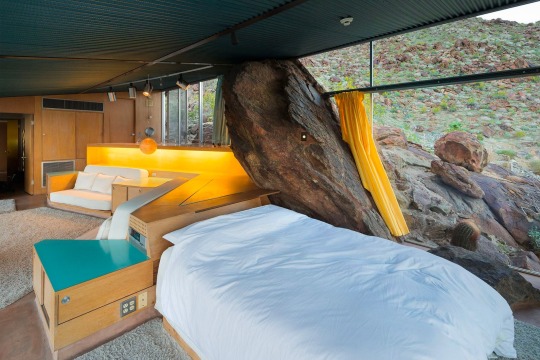

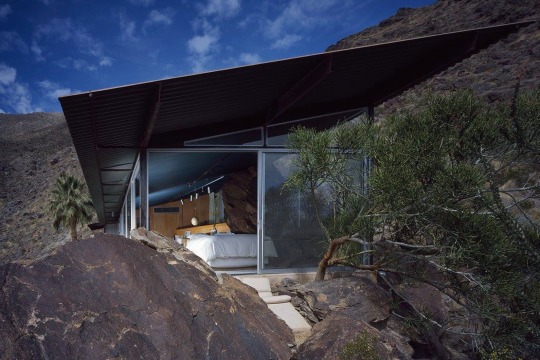

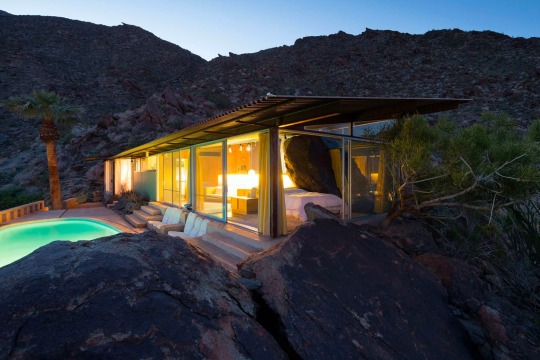



Frey House II Situé à Palm Springs, Californie. Conçu par l'architecte Albert Frey en 1964. Photo. Lee F. Mindel. - source MCM Daily.
67 notes
·
View notes
Text
Interview #494: Ryan Frigillana
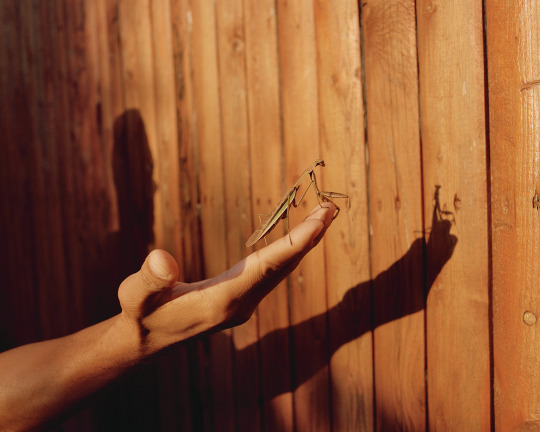
Ryan Frigillana is a Philippine-born lens-based artist living and working in New York. His work focuses on the fluidity of memory, intimacy, family identity, and visual culture, largely filtered through the lens of race and immigration. Embracing its plasticity, Frigillana explores photography’s relationship to context as a catalyst for thematic dialogue.
His first monograph, Visions of Eden, was published as two editions in 2020, and is held in the library collections of the MoMA, Getty Research Institute, and Smithsonian among others.
We spoke to find out more about Visions of Eden, his love for photobooks, and photography as a medium for introspection.

Lee Chang Ming Ryan Frigillana
Thanks for agreeing to do this! As we’ve just arrived into the new year, I want to start by asking: how did you arrive at photography and how has your practice evolved so far? Your earlier work was anything from still life to street photography, but your recent work seems to deal with more personal themes.
It’s my pleasure; thank you for having this conversation with me! Wow, looking back at how I’ve arrived at this point makes me feel so grateful for this medium, and excited to think of where it will lead me from here. I came to photography somewhat late. I was initially studying to become a nurse and was set to start a career in that field, but I found myself unhappy with where I was going. My mother was a nurse and I know what goes into being one; it’s not an easy job, and I respect those who do it, but my heart wasn’t in it. I found photography as a creative outlet during that stage of my life, and I’ve clung onto it ever since.
My first exposure to photography (no pun intended) came in the form of street and photojournalism. I would borrow books from the library a lot, consuming works by Magnum and other photographers working in that tradition. At the time, it was all I knew so that’s what I tried to emulate. Even early on in my undergrad career, these modes of creation were reinforced by curriculum and by what I saw from my own peers. My still-life work branches off of that same sentiment: the only names that were ever thrown around by professors were Penn and Mapplethorpe, so that’s who I studied. Thankfully over the years, I’ve been able to broaden that perspective through my own research. Though I don’t necessarily pursue street or constructed still-lifes anymore for my personal work, I’d like to think my technical skills (in regard to timing, composition, light) owe a debt to those past experiences.
I suppose now I’m starting to explore how photography can be used as language, to communicate ideas and internal conflicts. I’m thinking more about the power of imagery, its authorship, its implications, and how photographs have shaped, and continue to shape, our reality. That’s where my work is headed at the moment.
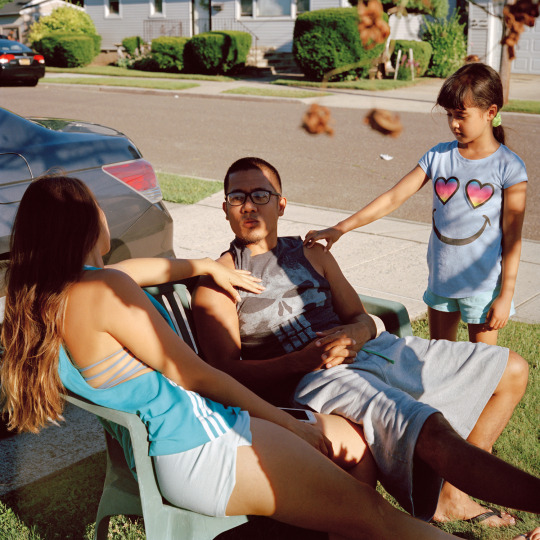
I liked how you mentioned photography as a language, which calls into question who we are speaking to when we make images and what kind of narrative we construct by putting photographs together.
In your work “Visions of Eden”, you trace your family’s journey as first-generation Filipino immigrants in America. I was quite struck by how you managed to link together original photography, archived materials and video stills. To me, with the original photography there was a sense of calm and clarity, perhaps in the composition. But with the archived material it was like peering through tinted glass, and the video stills felt like an unsteady memory. What was the editing process like for you and how did you decide what to include or exclude?
For me, editing is the hardest part about photography. Shooting is the enjoyable part of course because it can feel so cathartic. Sometimes when I shoot it feels almost like muscle memory in the sense that you see the world and you just react to it in a trained way. But with editing, it’s more of a cerebral exercise. More thought is involved when you have to deal with visual relationships, sequence, rhythm, and spacing, etc. The real creation of my work takes place in the editing process. That’s where the ingredients come together to form an identity.
When creating this identity, I not only have to think about what I want to say, but also how I want to say it. It’s like speaking; there are numerous ways you can communicate a single sentence. How are images placed in relation to one another? How large are they printed, or how much white space surrounds it? Are the images repeated? What’s on the following page? The preceding page? Is there text? How are they positioned on the spread? All of these little choices impact the tone of your work. And that’s not even mentioning tactile factors like paper stock or cover material. I think that’s why I have such a deep love for photobooks because 1) they’re physical objects and 2) someone has obsessed over every aspect of that object.
I’m aware that my photographs lately have a quiet, detached, somewhat stripped-down quality to them. I think that’s just a subconscious rejection of my earlier days shooting a lot of street where I was constantly seeking crowded frames and complexity in my compositions. As I’ve grown older, I realize less is more and if I can do more by saying less, that’s even better. Now, the complexity I seek lies in the work as a whole and how all these little parts can form something fluid and layered, and not easily definable.
For Visions of Eden, I wanted the work to feel somewhat syncopated and wandering in thought. That meant finding a balance between my quiet static photographs and the movement and energy of the video stills, or balancing the coldness of the illustrations with the warmth of the family snapshots. The work needed to be cohesive but have enough ambiguity for it to take life in someone else’s imagination. Peoples’ lived experiences in regard to immigration and religion are so complex that they can’t be narrated in any one definitive way. Visions of Eden, hopefully, is a rejection of that singularity.
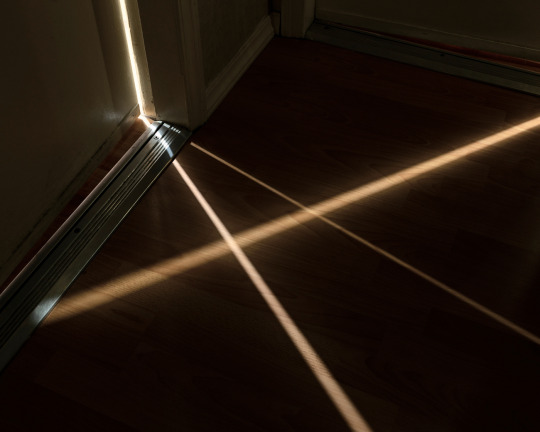
Yes, there’s definitely something special and intimate about flipping through a photobook! For your monograph, you recently released a second edition which is different from your first (redesigned, added images, etc.). Why did you decide to make it different? Was the editing mainly a solitary process?
The first edition was a partially hand-made object. Illustrations were printed on translucent vellum paper and then tipped into the gutter of the book. When you flip through the pages, those vellum sheets would overlap over certain images, creating a collage-like effect. That was my original concept for this book. Doing this, however, was so laborious and time consuming, and not to mention expensive! Regretfully, I wound up making only twenty copies of that first edition. I wanted the work shared with a wider audience so that’s why I decided to publish a second run.
The latest edition is more of a straight-forward production without the vellum paper. With this change in design, I had to reconfigure the layout. I took liberties in swapping out some images or adding new ones altogether. Also, a beautiful afterword was contributed by my friend, artist, writer, and curator Efrem Zelony-Mindell. I still feel so fortunate and grateful to have had my work seen and elevated by their words in my book.
For the most part, yes editing is quite a solitary process for me. But there does come a point when I feel it’s ready, where I share the work with a few trusted people. It’s always nice to have that outer support system. Much of Visions of Eden was created during my time in undergrad school so I had all sorts of feedback from peers and professors which I’m grateful for. But in the end, as the author, you ultimately have the final say in your work.
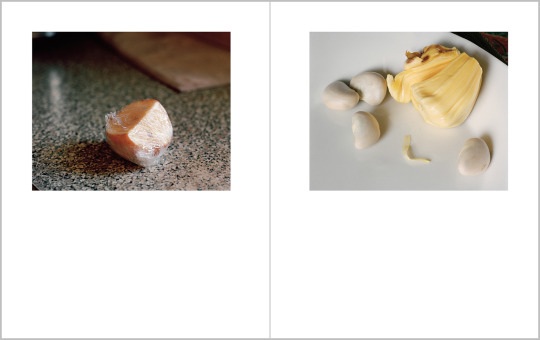
Given that Eden is a starting point and metaphor in the work, I was thinking about ideas of gardens, (forbidden) fruit, and movement of people.
How do you view yourself in relation to your place of birth? In your series, I see the most direct links in the letters, old photos where tropical foliage is present in the background, and the photo of the jackfruit (perhaps the only tropical fruit in this series).
I came to America when I was very young, about five years old. For my family and for many other families still living in the Philippines, America is seen as a sort of ideological Eden: a land of milk and honey, of wealth and excess. We all know that’s far from the truth. Every Eden has a caveat, a forbidden tree. Which leads me to ask: as an immigrant living in this country, what fruits were never intended for me?
I honestly don’t remember much about my childhood in the Philippines aside from fleeting memories of my relatives, the sounds of animals, the smell of rain and earth, the taste of my grandmother’s cooking. The identity that I carry with me now as a Filipino is not so much tied to the physical geography of a place but rather it is derived from a way of life, from shared stories, in the values we hold dear, passed on from generation to generation. This is a warm flame that lives on in me to this day as I write these words thousands of miles away from where I came.
Photographs have a way of shaping our memory and our relationship to the past, which in turn affects how we engage with the present. The family photographs and letters used in my book act as anchors in a meandering journey. They serve as landmarks that I can return to whenever I feel lost or need assurance so far away from “home”. They give me the comfort and affirmation that I need to navigate a space where I never really felt I belonged. The spread in my book that you mentioned—the jackfruit on one side, and the Saran-wrapped apple on the preceding page—was a reference to my duality as both Filipino and American. It’s a reminder and an acknowledgment that I am a sum of many things, of many people who have shaped me. If I flourish in life, it’s because my roots were nourished by love.
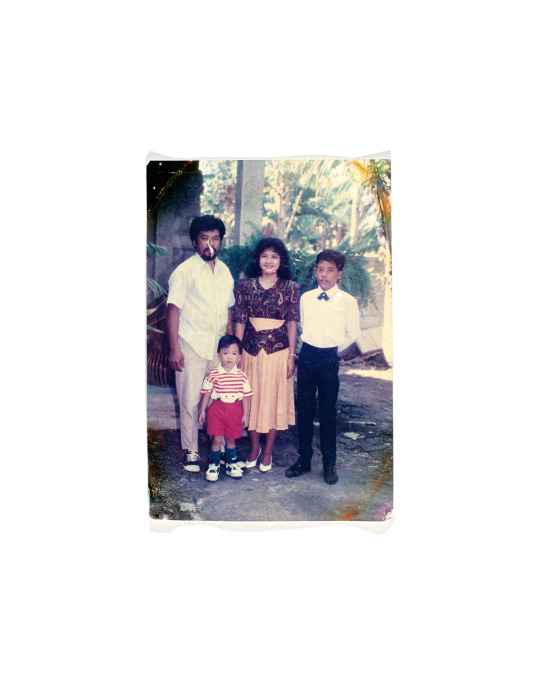
I like how you mentioned photos as anchors or landmarks. Isn’t that why we create and photograph? To mark certain points in our lives and to envision possible futures, like a cartographer mapping an inner journey. Do you feel like you and your relationships with those you photographed changed through the process of making your works?
When my parents took pictures of our family, it wasn’t done solely in the name of remembrance; it also served as an affirmation of ourselves and our journey—a celebration. Every birthday, vacation, school ceremony, or even the seemingly insignificant events of daily life were all photographed or video-taped as a way of saying to ourselves, “Here we are. Look how far we’ve come. Look at the life we’ve made. And here’s the proof”.
Now, holding a camera and photographing my family through my own lens still carries all of that celebratory joy, but with so much more possibility. Before I really took photography seriously, I never realized its potential as a medium for introspection, but that’s ultimately what it has become for me. In taking pictures of my family, I not only clarify my own feelings about them, but the act of photography itself informs and builds on my relationship with each person. The camera is not a mere recording device, but a tool for understanding, processing, and even expressing love...or resentment. Though I may not be visible in my pictures, my presence is there: in my proximity, my gaze, my focus.
Does all of this impact my relationships? Absolutely. Photographing another person willingly always demands some degree of trust and vulnerability from both sides. There’s a silent dialogue that occurs which feels like an exchange of secrets. I think that’s why I often don’t feel comfortable photographing other people unless we’re very close. Usually my family is open enough to reveal themselves to me, other times what they give can feel quite guarded. That’s a constant negotiation. After the photograph is made though, nobody ever emerges the same person because each of us has relinquished something, no matter how small.
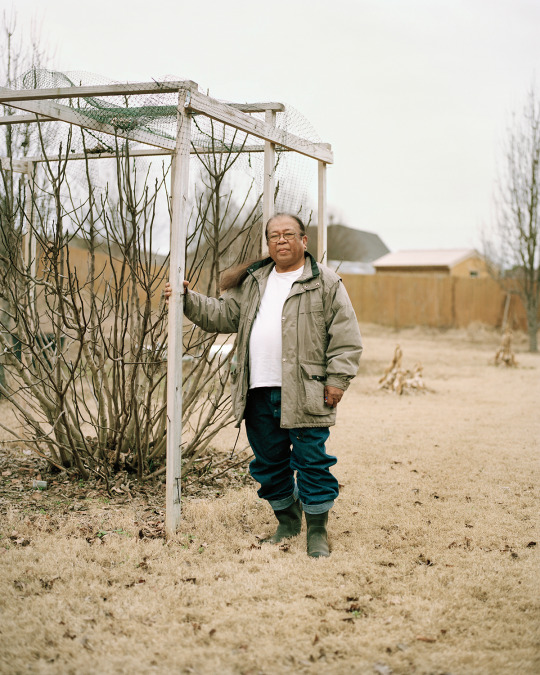
Being self-reflexive in photography is so important. I agree it should be a constant negotiation, but it’s something that bothers me these days – the power dynamic between the photographer and photograph, particularly for personal and documentary projects. More significantly, after the photograph has been made, who is really benefiting. But I guess if we are sensitive to that then perhaps we can navigate that tricky path and find a balance.
Right, finding that balance is key and sometimes there are no clear-cut answers. That power dynamic is something I always have to be mindful of. As the photographer, you are exercising a certain role and position. At the end of the day, you’re the one essentially “taking” what you need and walking away. There’s an inherent violence or aggression in the act of taking someone’s picture, no matter how well-intended it may be. This aggression carries even greater weight when working, as you say, in a genre like documentary where representation is everything.
I remember an undergrad professor of mine, Nadia Sablin, introducing me to the work of Shelby Lee Adams—particularly his Appalachian Legacy series. Adams spent twenty-five years documenting the disadvantaged Appalachian communities in his home state of Kentucky, visiting the same families over a long period of time. Though the photographs are beautifully crafted, they pose many questions in regard to exploitation, representation, and the aestheticization of suffering. He is or was, after all, an artist thriving and profiting off of these photographs. Salgado is another that comes to mind. This was the first time I really stopped to think about the ethics of image-making. Who is benefitting from it all?
I think the search for this balance is something each photographer has to reckon with personally. Though each situation may vary with different factors that have to be weighed, and context that must be applied, you can always ask yourself these same ever-pertinent questions: am I representing people in a dignified way, and what are my intentions with these images? Communication (listening), building relationships, acknowledging your power, and respecting the people you photograph are all foundational things to consider when exercising your privilege with the camera.
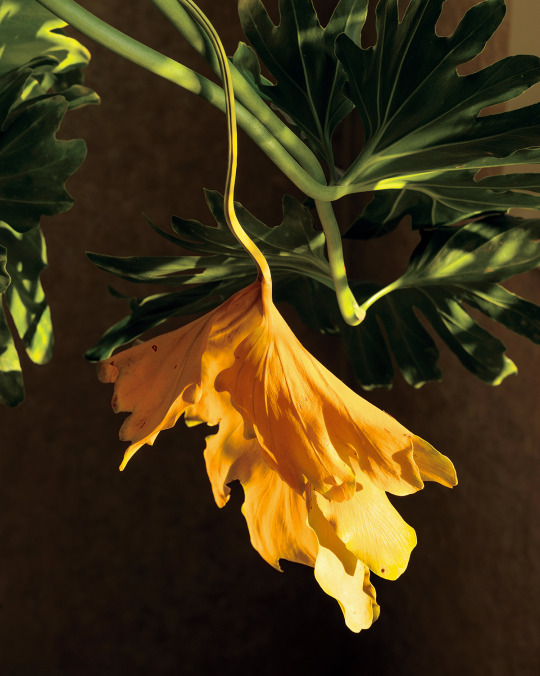
Well said! The process of making photographs can be tricky to navigate yet rewarding. Any upcoming projects or ideas? What’s keeping you busy these days?
Oh, let’s just say I’m constantly juggling 3-4 ideas in my head at any given time, but ninety percent of the time they don’t ever lead to anything finished haha. This past year has been tough on everyone I’m sure. I’ve been dealing a lot with personal loss and grief and the compounded isolation brought on by the pandemic, so for months I’ve been making photographs organically as a subconscious response to these internal struggles. It’s more of an exploration of grief itself as a natural phenomenon and force—like time or gravity. Grief is something everyone will experience in life and each of us deals with it differently, but in the end we have to let it run its course. I see these photographs as a potential body of work that could materialize as a zine or book one day, so we’ll see where that goes.
Other than that, I’ve been working on an upcoming collaboration project with Cumulus Photo. Speaking of which, I saw your photograph featured in their latest zine, running to the edge of the world. Congrats on that! It’s beautiful. But yeah, just trying my best to keep busy and sane, and improving myself any way I can.
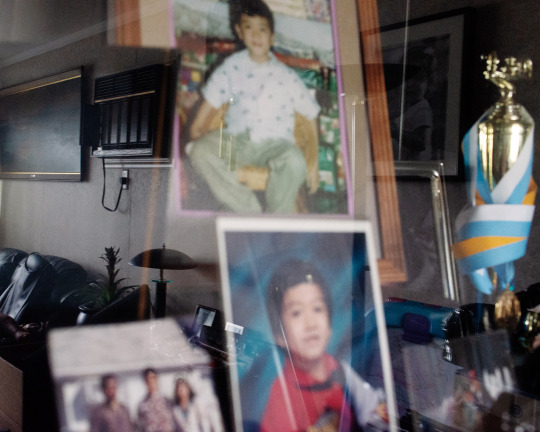
Thanks! Looking forward to your upcoming projects! Last question: any music to recommend?
I feel like my answer to this question can vary by the week. I go through phases where I exhaust whole albums on repeat until I get tired of them. So I’ll leave you with the two currently on my rotation: Angles by The Strokes, and Screamadelica by Primal Scream.
Thank you for your time!
Thank you for a lovely discourse. I had a lot of fun!
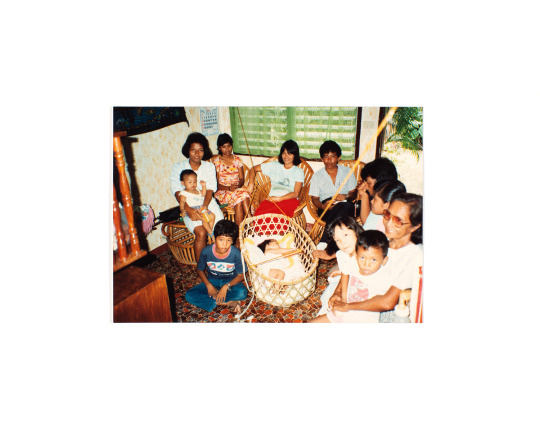
his website and Instagram.
Get more updates on our Facebook page and Instagram.
#Ryan Frigillana#nope fun#new york#photographer interview#artist interview#Contemporary Photography#Visions of Eden#PhotoBook
330 notes
·
View notes
Text
Back to School Sleep Tips : Help Your Child be ready (2021)
Back to School Sleep Tips : Help Your Child be ready (2021)
Alright, let me just start off here by saying, no judgment for what might have gone down in the last couple of months.
I know… I’m a child sleep consultant and you may think that I’m going to tell you off for the late bedtimes, inconsistent schedules, or any of the many naughty things that may have taken place over your summer holidays and during lock down.
But I get it. I really do.
I’m a mother myself and I know how precious these summer months are. You want to squeeze every minute of joy and togetherness you can from these glorious days. If it’s a choice between consistent bedtimes and staying up to watch as a family to watch Netflicks
That’s no choice at all.
So no matter what might have happened over the summer holidays and during lock down, all is forgiven. The mission now is to get your child back on track so that they can get back to sleep at a reasonable hour the day now they have gone back to school.
So I hope you’ll keep reading without fear of any finger wagging or talk of what you should have done differently.
I promise you, it’s not in here.
Set a Time For Bed and Stick to it
So first things first. What time should your kids be going to bed? Well, a lot of parents I work with are surprised to hear that I recommend somewhere between 7:00pm and 8:00pm at night.
They’re even more surprised when I tell them that I suggest they keep that bedtime until their child is about 12 years old.
There are two reasons why I think kids should be in bed, and by that I mean sleeping, by 8:00 at night.
1 – Kids Need SleepFirst, kids need at least 10 hours of sleep a night.
An extra hour or two on top of that is never a bad thing, but you obviously have to make those adjustments based on your own observations.
Regardless, if your toddler needs to be up by 7:00 A.M. in order to get ready for school, they should be asleep by 9:00 at the latest.
Factor in the time it takes them to get to sleep after they get into bed, plus the inevitable request for a glass of water or a totally silly insistence that they need to use the toilet half an hour after you close their door, and 8:00 is pretty much the latest they can get to bed and still get the sleep they need.
2 – Mummy and Daddy Time
Second, you, as a parent, and your partner if there’s one in the picture, need to exist child-free for a few hours a day. You need to be able to watch TV with swear words and sexual innuendo, to be able to eat some junk food without fear of being spotted, to just do grown-up things and to recharge those parenting batteries.
It’s vital to your relationship with your partner and with your kids.
Alright, so now that we know when to put our kids to bed, let’s move on to the significantly more difficult issue of how.
Don’t leave it to the last minute.
If they’ve been going to bed at around 9:00 for the better part of their holidays, try moving bedtime up by about 15 minutes every 4 days until you’re back to their normal bedtime.
If this requires a little deception on your part by adjusting the clocks in their room, you just go ahead and get deceptive. Sometimes the ends really do justify the means.
Establish a Bedtime Routine
If you had an effective bedtime routine before your summer holidays and the pandemic threw everything into upheaval, then try to re-implement it as much as possible.
Familiarity will definitely help your child settle back into the schedule quicker and with less resistance than trying out something new.
On the other hand, if this is your first go at implementing a bedtime routine, let me just stress how much easier a repetitive, predictable bedtime routine can make your life.
When your child’s body and brain start to associate things like baths, stories, brushing teeth, putting on PJs, all done in the same order at the same time every night, it cues up their melatonin production, making sleep come easier.
I seriously can’t recommend bedtime routines highly enough.
Use a Timer
Of course, things like baths and stories are super fun, so there is a tendency for your toddler to try and negotiate for more time in the bath, or one more story.
If you find yourself constantly having to play bad cop, a timer can be your best friend for keeping things on schedule, and as silly as it may sound, takes the blame off of you and puts it on the timer.
Mum can be reasoned with, but the timer is downright unwavering.
Turn of those screens
Along with the slack enforcement of bedtimes during the summer, we also tend to ease up on the rules surrounding TV, video games, or otherwise staring at screens in the hours leading up to bedtime.
After all, there’s no homework to be done, so maybe we can allow a little leeway for an extra episode of In The Night Garden or Peppa Pig
(Which, quite honestly, is as enticing for me as it is for my kids. )
The thing about screens, whether they’re phones, TVs, computers, or tablets, is that they put out a massive amount of blue light.
Our brains associate blue light with sunshine, and therefore daytime, so screens before bed can actually have the unwanted effect of firing your kid’s system back up when it should be powering down.
Try to avoid any screen time for at least two hours before bed.
TOP TIPS.
This also applies to adults, so if you’re having trouble falling asleep at night, try reading instead of watching TV before you turn in.
Turn to the dark side
And while we’re on the subject of light, for many of you living in the northern areas of the planet, you may notice that it doesn’t get dark until significantly later at 8:00pm, and the only thing that simulates sunlight better than a TV screen is actual sunlight.
If your child’s bedroom is still lit up like a Christmas tree when you’re putting them to bed, I suggest investing in a set of blackout blinds.
It doesn’t have to be anything fancy. You can get a six-pack of blinds on Amazon, or even something called non-adhesive window film, which is just plastic you can cut to size and slap up over the glass.
If you’re concerned about aesthetics and willing to spend the money, there are plenty of color options besides black that still block out the light. Whichever way you choose to do it, get that sunlight out of the bedroom.
It’ll make a world of difference, I promise you.
KEY INFORMATION.Having experienced some leniency regarding bedtime can suddenly transform your child into an astoundingly sharp lawyer.
Arguments for why they should be allowed to stay up later are likely to be heard for at least a few days and, potentially, the next eight or ten years. Luckily, parenting is not a democracy.
It is a glorious dictatorship where “Her Highness, the Momma,” makes all the rules.
Don’t give in to the pressure, because as I said earlier, this 8:00pm bedtime is going to be in place for several years. The sooner they accept that as the norm and their summertime hours as a special circumstance, the easier this whole bedtime thing will be for you and for them.
So there it is, folks! I hope you had yourselves a wonderful summer holiday, and that your children are safe and back in school or starting school again soon.
I promise you that, no matter what grade they’re headed into, nothing will help them go into the new school year with a better attitude and positive outlook than getting plenty of sleep.
And if this is your first experience with the kids out of the house since you became a mum, oh baby, let me tell you about the sweet days ahead. (Once you’ve gotten over the initial heartbreak, of course.)
Jennifer L. Vriend, PhD Fiona D. Davidson, MA Penny V. Corkum, PhD Benjamin Rusak, PhD, FRSC Christine T. Chambers, PhD Elizabeth N. McLaughlin, PhD (2013) Manipulating Sleep Duration Alters Emo- tional Functioning and Cognitive Performance in Children – Journal of Pediatric Psychology, Volume 38, Issue 10, 1 November 2013, Pages 1058–1069, https://doi.org/10.1093/jpepsy/jst033 Mindell J, Lee C, Goh D, Leichman E, Rotella K (2017). Sleep and Social-Emotional Develop- ment in Infants and Toddlers. Journal of Clinical Child & Adolescent Psychology 46:2, 236-246, DOI: 10.1080/15374416.2016.1188701 Sleep efficiency (but not sleep duration) of healthy school-age children is associated with grades in math and languages – Gruber, Reut et al. Sleep Medicine , Volume 15 , Issue 12 , 1517 – 1525.
1 note
·
View note
Text
Bespoke wooden Furniture Designs by Voguefurns
Furniture are not just some kind of inanimate things that are just sitting there in one corner of the home. Wooden Furniture are lot more than that. They have a lot of emotional value. And that’s why we tend to call it ‘heirloom’. In fact, no home is complete without good furniture and other items. Sturdy wooden furniture are carefully preserved and are handed down from generation to generation to sons and daughters, who inherit them proudly. Maybe you had faint memories of your grandpa using that old style rocking chair, which may seem incongruous today in the age funky cool furniture of urban design. But then these furniture have a priceless value and timelessness about it that you wouldn’t trade it even for millions.
So, why do we have this emotional connect with that ‘good old’ classic table or chair’ that your grandpa used to write his diaries on sitting by the window? It is the timelessness of the chair or table that brings back the memories of a bygone era.
And no one understands this philosophy better than the good people at Voguefurns. In the world of cut-throat world of furniture design, Voguefurns stands head and shoulders above the crowd, especially in Kolkata. Voguefurns, an iconic furniture showroom that understands the value of this ‘emotional connect’ we all have with classic furniture, has turned this into an amazing business mantra. They design, manufacture and sell beautiful and elegantly-designed furniture that appeal to a wide range of tastes and desires. High profile patrons and connoisseurs of fire art love this concept. And Voguefurns has perfected this fine art of elegant furniture, upto the hilt.
From robust and sturdy teak wood tables and chairs to trendy bookshelves and table lamps to plush TV lounges designs, Voguefurns straddles a wide spectrum of furniture world.

In this blog, we are going to look at the delicate nuances of furniture design practised by Voguefurns at its state-of-the-art manufacturing facility. Craftsmen with years of experience crouched over mock-ups working gingerly on furniture concepts, while the design heads work on redefining design on various concepts using advanced CAD software on computers. you can find skilled craftsmen with years of experience crouched over mock-ups or dummy's.
Each and every detail is studied and scrutinized online from various angle before the furniture designs could be turned over to the production department.
According to Lee F. Mindel, an architect in New York, “Interiors are no longer decorated, they’re curated.” And that goes for Voguefurns too. For, they do not manufacture furniture. They fuse technology and art into unique furniture. The result is furniture designs you have never seen anywhere in India, least of all in Kolkata.
The result is you get soulful-looking furniture that not only look beautiful and feel comfortable and but also look luxurious. What is great about Vogue’s furniture is that its promoters have this innate vision to bring ‘affordable luxury’ within the reach of discerning consumers. It is a kind of democratic ideal that classic furniture need not be the preserve of “Bold and the Beautiful”. Even common man can buy beautiful furniture. It is all about making luxury more affordable.
#best furniture#best furniture design#best furniture for small room#Bedroom Sets#Sofas#Wardrobes#Dining Tables#Voguefurns#Furniture Product
2 notes
·
View notes
Text
The impact of mobility scooters on their users
Taking everything into account, regardless of what side of the smaller scale portability and e-bike contention you fall on, the information shows society needs a feasible last-mile option in contrast to the present transportation alternatives that are clogging and contaminating the world's most crowded urban areas. The truth will surface eventually if the best last-mile elective winds up being e-bikes, dockless bicycles, or some new type of transportation yet to hit the boulevards.
As more established individuals begin to experience issues in strolling many utilize a portability bike to assist them with moving around. Profiting by improved structure, versatility bikes are turning into an undeniably famous portability gadget and are a typical sight on numerous boulevards.
Best Attractive Folding Mobility Image
https://foldingmobilityscooter.net/best-lightweight-foldable-mobility-scooter/

In any case, next to no is thought about their use or their effect as far as either personal satisfaction or useful wellbeing. While versatility bikes may improve the personal satisfaction of their clients, it is additionally conceivable that the stationary idea of their utilization brings about a decrease of physical usefulness and accordingly diminished capacities.
Before any considerable research can be done it is vital to comprehend the significance of a portability bike on the lives of the individuals that utilization them and to audit the underlying exploration distributed on the impact of bike use on phConsistently every individual in England makes a normal of 923 adventures, 22% of these are by foot (National Travel Survey, 2014).
The wellbeing results of dynamic vehicle, for example, strolling are generally recognized (Carsperson and Fulton, 2008; Hamer and Chida, 2007; Lee and Buchner, 2008; Murtagh et al., 2010). Numerous more seasoned individuals experience issues in strolling and the level of individuals in this gathering ascends with age (Mindell and Craig, 2005).
Contingent upon the explanations for the trouble, as individuals start to battle to walk they have a scope of choices open to them which can be utilized alone or in mix. They can; walk less regularly, walk less far, take increasingly incessant rest breaks while strolling, utilize open or private vehicle, utilize a versatility help for security, for example, a walker or a stick, or utilize a portability gadget as opposed to strolling, for example, a wheelchair or a versatility bike.
Versatility bikes are turning into an undeniably normal sight on numerous boulevards. Profiting by improved structure and picture just as a reduction in use disgrace, portability bikes have become an undeniably well known versatility help. They can be procured in huge grocery stores, in strip malls, at some vacation spots and guest focuses and are broadly accessible for buy including on the high road. In any case, in spite of their pervasiveness little is thought about their effect upon their clients physical wellbeing and physical capacities.
From a wellbeing writing point of view a versatility bike can be viewed as a mobile and physical movement substitution. It empowers its client to travel separations they already would have made by foot (or short separation vehicle trips) with no physical exertion (Hoenig et al., 2007; Steyn and Chan, 2008; Zagol and Krasuski, 2010). For some more seasoned individuals a portability bike can be a substitution for a vehicle and for the sorts of outings they would have made with a vehicle.
The Use Of Mobility Scooter
Power Chairs and Electric Mobility Scooters
1 note
·
View note
Text

In an open letter to the Academy, a long list of prominent filmmakers, including Oscar nominees and winners from branches including cinematographers, editors, production designers, sound and VFX, are calling for the decision to be reversed.
A lengthy list of leading filmmakers are blasting the Academy's plan to present four awards categories at the upcoming 91st Oscars during commercial breaks as "nothing less than an insult to those of us who have devoted our lives and passions to our chosen profession." They are calling for the Academy to reverse its decision.
Their remarks are part of an open letter that has been signed by such directors as Spike Lee, Martin Scorsese and Quentino Tarantino; cinematographers including Roger Deakins, Emmanuel "Chivo" Lubeski and Robert Richardson; editors Tom Cross, William Goldenberg and Mary Jo Markey; and additional past and present Oscar nominees and winners from those branches and others including production design, sound and VFX.
With the Feb. 24 awards show, set to air on ABC, just 11 days away, the Academy and the show's producers Donna Gigliotti and Glenn Weiss are now facing what is becoming an open revolt. The Academy did not immediately respond to requests for comment.
Relegating these essential cinematic crafts to lesser status in this 91st Academy Awards ceremony is nothing less than an insult to those of us who have devoted our lives and passions to our chosen profession," the letter reads. "When the recognition of those responsible for the creation of outstanding cinema is being diminished by the very institution whose purpose it is to protect it, then we are no longer upholding the spirit of the Academy’s promise to celebrate film as a collaborative art form."
In an email to the Academy membership on Monday, Academy president John Bailey, who belongs to the cinematographers branch, laid out the plan for this year's show, including the presentation of four Oscar categories — cinematography, film editing, live-action shorts and makeup and hairstyling — during commercial breaks. (This was first announced last year but without details and specific categories.)
Bailey emphasized that the Academy is "still honoring the achievements of all 24 awards on the Oscars." In the case of the four categories that will be announced during commercial breaks, the winners' speeches will air later in the broadcast, he said. The plans call for there to be a rotation each year, meaning that at least four different categories would use this format in 2020.
The complete letter follows. Additional names will be added at filmmakers' request.
An Open Letter to The Academy of Motion Picture Arts & Sciences and The Producers of the 91st Annual Academy Awards Broadcast:
On Monday, February 11, 2019, John Bailey, President of the Academy of Motion Picture Arts & Sciences, announced that this year’s Oscar presentations for Best Cinematography — along with Film Editing, Live Action Short and Makeup and Hairstyling — will not be broadcast live, but rather presented during a commercial break. This decision was made to reduce the length of the show from four hours to three. The vocal response from our peers and the immediate backlash from industry leaders over the Academy’s decision makes it clear that it’s not too late to have this decision reversed.
The Academy was founded in 1927 to recognize and uphold excellence in the cinematic arts, inspire imagination and help connect the world through the universal medium of motion pictures.
Unfortunately, we have drifted from this mission in our pursuit of presenting entertainment rather than in presenting a celebration of our art form and the people behind it.
Relegating these essential cinematic crafts to lesser status in this 91st Academy Awards ceremony is nothing less than an insult to those of us who have devoted our lives and passions to our chosen profession.
The show’s director, Glenn Weiss, has stated that he will determine what “emotionally resonant” moments from the four winners’ speeches will be selected to air later in the broadcast. The show will cut any additional comment from presenters, as well as any recitation of the nominees as they see fit.
We consider this abbreviation and potential censorship to run contrary to the spirit of the Academy’s mission.
Since its inception, the Academy Awards telecast has been altered over time to keep the format fresh, but never by sacrificing the integrity of the Academy’s original mission.
When the recognition of those responsible for the creation of outstanding cinema is being diminished by the very institution whose purpose it is to protect it, then we are no longer upholding the spirit of the Academy’s promise to celebrate film as a collaborative art form.
To quote our colleague Seth Rogen, “What better way to celebrate achievements in film than to NOT publicly honor the people whose job it is to literally film things.”
Signed,
Cinematographers
Dion Beebe
Bill Bennett
Roger Deakins
Peter Deming
Caleb Deschanel
Robert Elswit
Mauro Fiore
Greig Fraser
Janusz Kaminski
Ellen Kuras
Ed Lachman
Robert Legato
Emmanuel Lubezki
Anthony Dod Mantle
Seamus McGarvey
Chris Menges
Dan Mindel
Reed Morano
Rachel Morrison
Guillermo Navarro
Phedon Papamichael
Wally Pfister
Rodrigo Prieto
Robert Primes
Robert Richardson
Linus Sandgren
John Seale
Newton Thomas Sigel
Vittorio Storaro
John Toll
Hoyte van Hoytema
Kees van Oostrum
Roy Wagner
Directors
Damien Chazelle
Cary Joji Fukunaga
Spike Jonze
Ang Lee
Spike Lee
Dee Rees
Seth Rogen
Martin Scorsese
Quentin Tarantino
Filmmakers
Kym Barrett
Judy Becker
Alan Edward Bell
Erin Benach
Avril Beukes
Consolata Boyle
Maryann Brandon
Alexandra Byrne
Milena Canonero
Chris Corbould
Hank Corwin
Tom Cross
Nathan Crowley
Sophie De Rakoff
Chris Dickens
Bob Ducsay
Lou Eyrich
Dante Ferretti
Paul Franklin
Dana Glauberman
William Goldenberg
Affonso Goncalves
Adam Gough
Jon Gregory
Dorian Harris
Joanna Johnston
Paul Lambert
Mary Jo Markey
Joi McMillon
Ellen Mirojnick
Stephen Mirrione
Bob Murawski
John Ottman
Sandy Powell
Fred Raskin
Tatiana S. Riegel
Elísabet Ronaldsdóttir
Mayes Rubeo
Nat Sanders
J.D. Schwalm
Anna B. Sheppard
Terilyn A. Shropshire
Joan Sobel
Michael Tronick
Mark Ulano
Martin Walsh
David Wasco
Billy Weber
Julie Weiss
Michael Wilkinson
Hughes Winborne
Janty Yates
8 notes
·
View notes